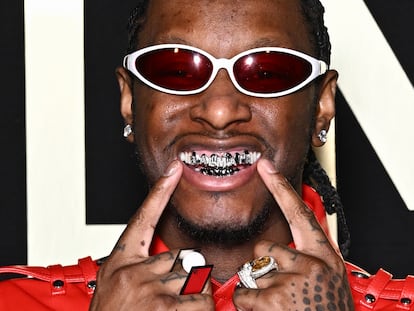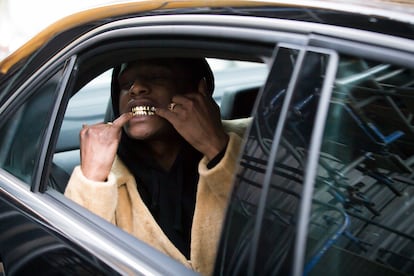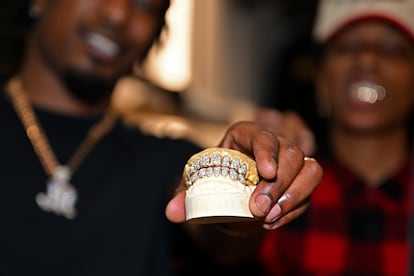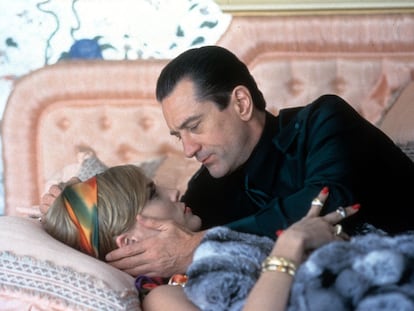An $850,000 dental crown? The history of grills, and why today’s stars are wearing them
This ancient jewelry technique worn by millionaires and mafiosi hit the streets thanks to rappers and was eventually copied by pop stars. Popularized by Madonna, Rosalía and Kanye West, they’re now available to anyone willing to pay a couple hundred dollars

It took place just a week ago, but it already seems a world apart. At the 66th Grammy Awards ceremony, a couple made the scene in what at the time seemed like a state of absolute bliss, two cover stars for Latin music’s moment of triumph. Argentina’s Nicki Nicole and Mexico’s Peso Pluma were one of the evening’s main attractions, a Spanish-speaking, perreo-friendly version of the great Hollywood couple. In photos from the evening, the perfect illustration of short-lived romantic union, both artists pose, smiling. She, with immaculate white teeth. He, with a mouth full of gold.
A little less than a week later, the couple had ceased to exist. But those images will be around forever. Perhaps in a few years, future observers will ask why artists like Peso Pluma chose to adorn their teeth with gold, gems and other noble materials that glimmer in the light. Grills — jewelry pieces designed to cover one or several teeth — have gone from an esthetic option favored by members of several subcultures, like hip-hop, to becoming the stylistic go-to of pop stars, who shell out millions for them while at the height of their personal wealth. Last month, several U.S. publications disclosed that Kanye West paid $850,000 for the titanium grill he wore in an Instagram post, a design inspired by the James Bond villain, Jaws (who popped up in The Spy Who Loved Me and Moonraker). The good news for mere mortals is that there are basic grill models designed for those living lives far removed from those of the Hollywood elite, starting around $161 for a gold hoop in one’s fang.


From Etruscans to rappers
In recent years, we’ve seen them on Dua Lipa, Bella Hadid, Justin Bieber, Beyoncé and Miley Cyrus. Others, like Rosalía, have adapted them to their personal whims, with glinting pieces in the form of the Motomami’s butterfly logo. This hypothetical spectator of the future may ask themselves various questions. Among them, why? And above all, where did these things come from?
The adornment of the mouth with metals or precious stones may seem innovative, a eureka moment fit for an era in which celebrities are obliged to find ways to stand out in the chaos of a crowded red carpet or our Instagram feeds. But in fact, the practice is as old as human discovery of these shimmering materials, not to mention the consequent desire to sport them as proof of our social status. The presence of dental ornamentation has been documented across the planet and going back millennia. It is known that Southeast Asian civilizations utilized the accessories going back as far as 4,000 years ago, thanks to remains that have been uncovered in the Philippines. Similar pieces have been documented from the Etruscan civilization, and Mayan culture also left traces of mouth decorations. By the time the 20th century rolled around, the use of gold on teeth was — well, first of all, an indicator of a healthy economy, but also, a replacement for a lost tooth, and later, a somewhat obscene boast of one’s position somewhere outside the realm of law-abiding society. They were worn by mafia bosses, for example. But the modern-day boom in gold, shiny teeth had its origins in another, more recent culture that draws, in part, from the esthetics of those same crime bosses: hip-hop.


There’s no consensus on who the first rapper was to use a golden grill on their teeth, but Slick Rick was the one who began to popularize the look, with his debut record in 1988. That moment kicked off an era in which gold and shiny elements began to pop up on necks, hands, ears and mouths alike. Hip-hop culture, which embraced luxury wholeheartedly, began to make a practice that had fallen into disuse its own — all but erasing its previous connection to dental loss. Along the way, it gave the accessories a new name, or rather, several: known as fronts, golds or grills, it is this last moniker that has come to infiltrate popular culture as a symbol of ostentatious pride, the street equivalent to wearing a Rolex on one’s wrist (though hip-hop rocks that look as well).
There is one marquee name when it comes to the popularization of the accessory. In the early 1980s, a young man of Surinamese origin named Eddie Plain set out to find a way to adorn teeth without replacing them with metal, as was the practice at the time. As told in his biography Mouth Full of Golds, Plain wanted to start a jewelry business based on dental applications that would not harm the teeth, and that wouldn’t be permanent. To do so, he studied the possibilities that lay in molds that could create pieces that covered the teeth, but could be easily removed. That moment, which coincided with the rise of hip-hop, proved perfect for his budding company. From Brooklyn, where his family had first arrived in the United States, he moved to Atlanta, where he became an institution in the rap scene and created personalized designs for aspiring artists to stars, or really anyone who wanted their status to shine out from their mouths.
How grills became mainstream
In 1992, Madonna was at the height of her skills as pop star and trendsetter, the majority of her trends having been gleaned from urban subcultures. In her visual reinvention for Erotica, which came accompanied by her polemic book Sex, the singer took an esthetic step that at the time seemed tremendously risky: a gold tooth. Equipped with the accessory, she was photographed, shot music videos and even fell victim to Millán Salcedo’s pelvic thrust in one memorable interview. What in that moment seemed like just another eccentricity of a star addicted to the epic was actually the entry of yet another street and hip-hop trend into pop culture.

And so, the grill closed the gap between subculture and mass culture. Meanwhile, in hip-hop, grills continued to be one of the hallmarks of the genre’s artists, especially in the South. Grills began to be seen in cities like Houston, courtesy of figures like Johnny Dang, a Vietnamese-born jeweler who has made a fortune creating custom designs for artists like Lil’ Wayne and Cardi B. The rise of trap, with its more daring esthetic canon featuring looks like facial tattoos, only served to reinvigorate urban fashion’s interest in grills.
In today’s world of pop, the eternal search for street culture with which to varnish one’s authenticity has led artists to continue to incorporate grills into their lexicon, first as a daring gesture and later, as part of the norm. Rihanna, Kim Kardashian, Kylie Jenner and athletes like Lebron James have sported them. They’ve also become a power move in Hollywood, as when they were worn by the director of the Oscar-winning film Moonlight, Barry Jenkins.

That transition from discreet luxury to the kind that is unabashedly declared is perhaps key to the rise in popularity of grills. They make a shining mouth such a direct declaration, one so estranged from what “everyone else” thinks, that they seem specially designed for an era in which the only thing that will endure, at least for a little while, are our photos.
Sign up for our weekly newsletter to get more English-language news coverage from EL PAÍS USA Edition
Tu suscripción se está usando en otro dispositivo
¿Quieres añadir otro usuario a tu suscripción?
Si continúas leyendo en este dispositivo, no se podrá leer en el otro.
FlechaTu suscripción se está usando en otro dispositivo y solo puedes acceder a EL PAÍS desde un dispositivo a la vez.
Si quieres compartir tu cuenta, cambia tu suscripción a la modalidad Premium, así podrás añadir otro usuario. Cada uno accederá con su propia cuenta de email, lo que os permitirá personalizar vuestra experiencia en EL PAÍS.
¿Tienes una suscripción de empresa? Accede aquí para contratar más cuentas.
En el caso de no saber quién está usando tu cuenta, te recomendamos cambiar tu contraseña aquí.
Si decides continuar compartiendo tu cuenta, este mensaje se mostrará en tu dispositivo y en el de la otra persona que está usando tu cuenta de forma indefinida, afectando a tu experiencia de lectura. Puedes consultar aquí los términos y condiciones de la suscripción digital.
More information
Archived In
Últimas noticias
Most viewed
- Sinaloa Cartel war is taking its toll on Los Chapitos
- Oona Chaplin: ‘I told James Cameron that I was living in a treehouse and starting a permaculture project with a friend’
- Reinhard Genzel, Nobel laureate in physics: ‘One-minute videos will never give you the truth’
- Why the price of coffee has skyrocketed: from Brazilian plantations to specialty coffee houses
- Silver prices are going crazy: This is what’s fueling the rally










































